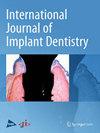Meta-analysis of the survival rate and postoperative infection rate of primary and secondary implants after vascularized fibula transplantation for reconstruction of jaw defects
IF 3.1
3区 医学
Q1 DENTISTRY, ORAL SURGERY & MEDICINE
引用次数: 0
Abstract
Vascularized fibula flap transplantation is the most effective and common method to repair the jaw defects. In addition, implantation is the first choice to restore dentition on the graft fibula. Implants are usually implanted at least 6 months after fibula transplantation. Primary implantation of implants during surgery can restore the dentition earlier, but whether this method can achieve the same restorative effect as secondary implantation is still uncertain. This article aims to compare the survival rate and complications between primary and secondary implantation through meta-analysis. This meta-analysis was conducted according to PRISMA protocol and the Cochrane Handbook of Systematic Reviews of Interventions. According to the inclusion and exclusion criteria, we selected the PubMed, Embase, Web of Science, Cochrane Library, Chinese National Knowledge Infrastructure (CNKI), Chinese BioMedical Literature Database (CBM) according to established inclusion and exclusion criteria. The Newcastle–Ottawa Scale (NOS) was used to assess the quality of the included studies. Meta-analysis was conducted to compare the survival rate and postoperative infection rate of primary and secondary implantation. Seven studies were involved in our research, involving 186 patients. Five of the studies detailed implant success in 106 patients (primary implantation 50, secondary implantation 56), and four studies documented infection after implantation in 117 patients (primary implantation 52, secondary implantation 65); the survival rate of the primary implantation was 93.3%, and the incidence of postoperative infection was 17.3%. The survival rate of the secondary implantation was 93.4%, and 23.1% had postoperative infection. Meta-analysis showed that there was no significant difference in the survival rate between primary implantation and secondary implantation, OR = 0.813 (95% CI 0.383–1.725, P = 0.589 > 0.05), and there was no significant difference in the incidence of postoperative infection, OR = 0.614 (95% CI 0.239–1.581, P = 0.312 > 0.05). Based on the results of this study, the research found no significant difference in the survival rate or infection rates between primary and secondary implantation. After appropriate indications selection, primary implantation can be used to reconstruct the dentition with less waiting time, reduce the impact of radiotherapy, and bring a higher quality of life for patients.血管化腓骨移植重建颌骨缺损后主要和次要植入物存活率及术后感染率的 Meta 分析
血管化腓骨瓣移植是修复颌骨缺损最有效、最常用的方法。此外,种植也是移植腓骨恢复牙齿的首选。种植体通常在腓骨移植后至少 6 个月植入。在手术中初次植入种植体可以更早地恢复牙齿,但这种方法是否能达到与二次植入相同的修复效果仍不确定。本文旨在通过荟萃分析比较一次种植和二次种植的存活率和并发症。本荟萃分析根据 PRISMA 协议和 Cochrane 《干预措施系统回顾手册》进行。根据纳入和排除标准,我们选择了 PubMed、Embase、Web of Science、Cochrane Library、中国国家知识基础设施(CNKI)、中国生物医学文献数据库(CBM)。采用纽卡斯尔-渥太华量表(NOS)评估纳入研究的质量。对初次植入和二次植入的存活率和术后感染率进行了元分析比较。我们的研究共涉及 7 项研究,186 名患者参与其中。其中 5 项研究详细记录了 106 例患者的植入成功率(初次植入 50 例,二次植入 56 例),4 项研究记录了 117 例患者的植入后感染情况(初次植入 52 例,二次植入 65 例);初次植入的存活率为 93.3%,术后感染发生率为 17.3%。二次植入的存活率为 93.4%,术后感染率为 23.1%。元分析显示,初次植入和二次植入的存活率无显著差异,OR = 0.813(95% CI 0.383-1.725,P = 0.589 > 0.05),术后感染发生率无显著差异,OR = 0.614(95% CI 0.239-1.581,P = 0.312 > 0.05)。根据这一研究结果,研究发现初次植入和二次植入在存活率和感染率上没有明显差异。在选择合适的适应症后,一次种植可以在更短的等待时间内重建牙列,减少放疗的影响,为患者带来更高的生活质量。
本文章由计算机程序翻译,如有差异,请以英文原文为准。
求助全文
约1分钟内获得全文
求助全文
来源期刊

International Journal of Implant Dentistry
DENTISTRY, ORAL SURGERY & MEDICINE-
CiteScore
1.70
自引率
7.40%
发文量
53
审稿时长
13 weeks
期刊介绍:
The International Journal of Implant Dentistry is a peer-reviewed open access journal published under the SpringerOpen brand. The journal is dedicated to promoting the exchange and discussion of all research areas relevant to implant dentistry in the form of systematic literature or invited reviews, prospective and retrospective clinical studies, clinical case reports, basic laboratory and animal research, and articles on material research and engineering.
 求助内容:
求助内容: 应助结果提醒方式:
应助结果提醒方式:


